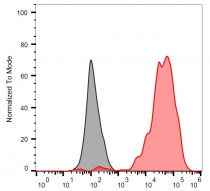ARG42343
anti-acidic Cytokeratin antibody [AE1] (PE)
anti-acidic Cytokeratin antibody [AE1] (PE) for Flow cytometry and Human,Mouse,Rat,Cat,Chicken,Dog,Primates,Rabbit
Overview
| Product Description | PE-conjugated Mouse Monoclonal antibody [AE1] recognizes acidic Cytokeratin |
|---|---|
| Tested Reactivity | Hu, Ms, Rat, Cat, Chk, Dog, NHuPrm, Rb |
| Tested Application | FACS |
| Specificity | Mouse monoclonal antibody AE1 recognizes acidic type cytokeratins (intracellular antigens), namely K10, 14, 15, 16, 19 (40-56 kDa). This antibody stains well the basal layer of epidermis and most epithelia. |
| Host | Mouse |
| Clonality | Monoclonal |
| Clone | AE1 |
| Isotype | IgG1 |
| Target Name | acidic Cytokeratin |
| Antigen Species | Human |
| Immunogen | Human epidermal keratins. |
| Conjugation | PE |
| Alternate Names | KPP; K10; CK-10; BIE; Keratin, type I cytoskeletal 10; Cytokeratin-10; CK10; BCIE; Keratin-10; EHK |
Application Instructions
| Application Suggestion |
|
||||
|---|---|---|---|---|---|
| Application Note | * The dilutions indicate recommended starting dilutions and the optimal dilutions or concentrations should be determined by the scientist. |
Properties
| Form | Liquid |
|---|---|
| Purification | Purified |
| Buffer | PBS and 15 mM Sodium azide. |
| Preservative | 15 mM Sodium azide |
| Concentration | 0.1 mg/ml |
| Storage Instruction | Aliquot and store in the dark at 2-8°C. Keep protected from prolonged exposure to light. Avoid repeated freeze/thaw cycles. Suggest spin the vial prior to opening. The antibody solution should be gently mixed before use. |
| Note | For laboratory research only, not for drug, diagnostic or other use. |
Bioinformation
| Database Links | |
|---|---|
| Gene Symbol | KRT10 |
| Gene Full Name | keratin 10, type I |
| Background | This gene encodes a member of the type I (acidic) cytokeratin family, which belongs to the superfamily of intermediate filament (IF) proteins. Keratins are heteropolymeric structural proteins which form the intermediate filament. These filaments, along with actin microfilaments and microtubules, compose the cytoskeleton of epithelial cells. Mutations in this gene are associated with epidermolytic hyperkeratosis. This gene is located within a cluster of keratin family members on chromosome 17q21. [provided by RefSeq, Jul 2008] |
| Function | Plays a role in the establishment of the epidermal barrier on plantar skin. (Microbial infection) Acts as a mediator of S.aureus adherence to desquamated nasal epithelial cells via clfB, and hence may play a role in nasal colonization. (Microbial infection) Binds S.pneumoniae PsrP, mediating adherence of the bacteria to lung cell lines. Reduction of levels of KRT10 keratin decrease adherence, overexpression increases adherence. Neither protein has to be glycosylated for the interaction to occur. [UniProt] |
| Cellular Localization | Secreted, extracellular space. Note=Localized on the surface of desquamated nasal epithelial cells. [UniProt] |
| Calculated MW | 59 kDa |
Images (1) Click the Picture to Zoom In






